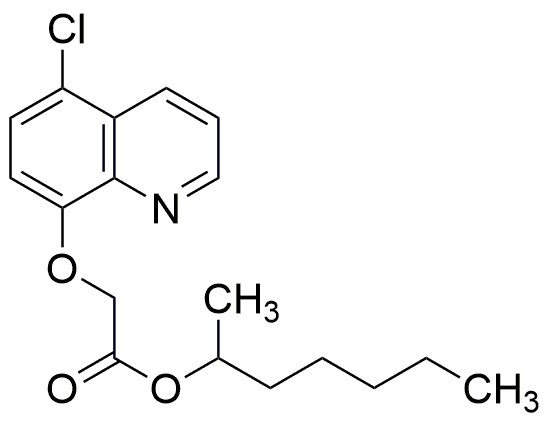Cloquintocet-mexyl is widely utilized in research focused on:
- Agricultural Herbicide: It serves as a selective herbicide in various crops, particularly in cereals, helping farmers manage weed populations effectively while minimizing damage to crops.
- Crop Protection: The compound enhances the efficacy of other herbicides, allowing for lower application rates and reduced environmental impact, which is crucial for sustainable farming practices.
- Research on Herbicide Resistance: Scientists study its mechanisms to better understand and combat herbicide-resistant weed species, providing insights that can lead to more effective weed management strategies.
- Formulation Development: It is used in the development of advanced pesticide formulations, improving stability and performance, which is essential for manufacturers looking to create competitive products.
- Environmental Impact Studies: Researchers assess its environmental behavior and degradation pathways, contributing to regulatory assessments and ensuring safe use in agricultural practices.
Información general
Propiedades
Seguridad y normativas
Aplicaciones
Cloquintocet-mexyl is widely utilized in research focused on:
- Agricultural Herbicide: It serves as a selective herbicide in various crops, particularly in cereals, helping farmers manage weed populations effectively while minimizing damage to crops.
- Crop Protection: The compound enhances the efficacy of other herbicides, allowing for lower application rates and reduced environmental impact, which is crucial for sustainable farming practices.
- Research on Herbicide Resistance: Scientists study its mechanisms to better understand and combat herbicide-resistant weed species, providing insights that can lead to more effective weed management strategies.
- Formulation Development: It is used in the development of advanced pesticide formulations, improving stability and performance, which is essential for manufacturers looking to create competitive products.
- Environmental Impact Studies: Researchers assess its environmental behavior and degradation pathways, contributing to regulatory assessments and ensuring safe use in agricultural practices.
Documentos
Hojas de datos de seguridad (HDS)
La SDS proporciona información de seguridad completa sobre la manipulación, el almacenamiento y la eliminación del producto.
Especificación del producto (PS)
La PS proporciona un desglose completo de las propiedades del producto, incluida la composición química, el estado físico, la pureza y los requisitos de almacenamiento. También detalla los rangos de calidad aceptables y las aplicaciones previstas del producto.
Certificados de análisis (COA)
Busque certificados de análisis (COA) ingresando el número de lote del producto. Los números de lote y de partida se pueden encontrar en la etiqueta de un producto después de las palabras "Lote" o "Lote".
Número de catálogo
Número de lote/lote
Certificados de origen (COO)
Este certificado de origen confirma el país en el que se fabricó el producto y también detalla los materiales y componentes utilizados en él y si se deriva de fuentes naturales, sintéticas u otras fuentes específicas. Este certificado puede ser necesario para cumplir con las normativas aduaneras, comerciales y regulatorias.
Número de catálogo
Número de lote/lote
Hojas de datos de seguridad (HDS)
La SDS proporciona información de seguridad completa sobre la manipulación, el almacenamiento y la eliminación del producto.
DownloadEspecificación del producto (PS)
La PS proporciona un desglose completo de las propiedades del producto, incluida la composición química, el estado físico, la pureza y los requisitos de almacenamiento. También detalla los rangos de calidad aceptables y las aplicaciones previstas del producto.
DownloadCertificados de análisis (COA)
Busque certificados de análisis (COA) ingresando el número de lote del producto. Los números de lote y de partida se pueden encontrar en la etiqueta de un producto después de las palabras "Lote" o "Lote".
Número de catálogo
Número de lote/lote
Certificados de origen (COO)
Este certificado de origen confirma el país en el que se fabricó el producto y también detalla los materiales y componentes utilizados en él y si se deriva de fuentes naturales, sintéticas u otras fuentes específicas. Este certificado puede ser necesario para cumplir con las normativas aduaneras, comerciales y regulatorias.


